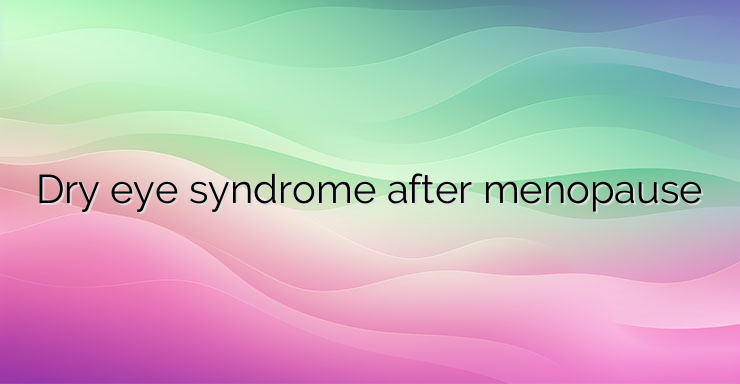Menopause in women is a stage of life that is characterized by many changes in the body. Approximately 61% of premenopausal and menopausal women develop dry eye syndrome. Menopause is the period that begins after the cessation of menstrual bleeding for more than 12 consecutive months. It usually occurs after the age of 50. Before this, there is a period of perimenopause, which in itself represents a transition to menopause, and after it there is a postmenopausal period. The duration of perimenopause can last from several months to several years, most commonly occurring in the mid-40s. During menopause, a woman’s body produces an atypical amount of hormones – less estrogen, progesterone and androgens. This leads to the appearance of various symptoms that create discomfort in everyday life, such as sweating, insomnia and hot flashes. In addition to these symptoms, complaints characteristic of dry eye syndrome very often appear in menopause – a feeling of dryness, feeling of grains of sand or a “foreign body”, burning, redness and itching in the eyes. Dry eye syndrome is a multifactorial disease that affects the surface of the eye. This disorder can be observed in any age and gender. However, according to a number of studies, it is especially common among women, especially those who have reached menopause. Dry eye syndrome can occur as a result of reduced production of tear secretion from the accessory lacrimal glands, as well as a disturbance in the lipid layer of the tear film, which leads to greater evaporation of tears. Epithelial cells located on the cornea can also undergo some changes. During menopause, the levels of androgen hormones decrease, leading to the involvement of the meibomian and lacrimal glands of the eyelids. The main property of the meibomian glands is to produce a fatty film that ensures the longer retention of the tear film on the ocular surface. When it is lowered, increased evaporation of lipids, instability of the tear film and increased dryness in the eyes are observed. When these glands are affected, the eyelids can become inflamed, further reducing the quality and rate of tear film production. According to some scientists, dry eye syndrome is associated with changes in estrogen levels. This may explain why many women experience dry eye symptoms during certain periods of their monthly cycle or while taking contraceptives that alter their hormone levels. Symptoms of dry eye syndrome include red eyes – injection, burning and dryness of the eyes, the appearance of inflammation, blurring of the image, sensation of grit or a foreign body in the eye, and excessive tearing of the eye. In the presence of some of these hormones, consultation with an ophthalmologist is recommended, who can prescribe appropriate treatment. After researching and determining the missing elements of the tear film,the ophthalmologist can recommend suitable drops for topical application. In addition to these, in some cases, the application of antibiotics, corticosteroids or anti-inflammatory drugs is possible. With good control of the levels of the various hormones disturbed during menopause, the severity of the symptoms that appear, including those affecting vision, could be reduced. Management of menopause depends on the observed symptoms, as they can vary from woman to woman. According to studies, it is possible to reduce complaints with the help of a healthy diet. The risk of dry eye syndrome among postmenopausal women can be reduced by staying well hydrated, getting enough sleep, using specially prescribed eye drops, taking omega-3 fatty acids, reducing exposure to dust, and more. allergens, maintaining good air humidity in the home, as well as reducing the use of screen devices. Having dry eye syndrome can increase the risk of allergic eye manifestations, Sjögren’s syndrome, and cause discomfort when wearing contact lenses. Increased dryness in the eyes worsens the allergy symptoms of the visual apparatus, because the amount of tears needed to clean the eyes is reduced. Dry eye syndrome can also be a symptom of another systemic disease characterized by dry eyes and mouth – Sjögren’s syndrome. References: https://www.optometrists.org/general-practice-optometry/guide-to-eye-conditions/dry-eye/what-is-dry-eye-syndrome/dry-eye-and-menopause/ https: //www.dryeyecare.net/2021/04/08/whats-the-link-between-dry-eye-and-menopause/ https://www.dryeyeandme.co.uk/5-things-you-need- to-know-about-menopause-dry-eye/ https://www.medicalnewstoday.com/articles/dry-eyes-with-menopause#symptomsas the amount of tears needed to cleanse the eyes is reduced. Dry eye syndrome can also be a symptom of another systemic disease characterized by dry eyes and mouth – Sjögren’s syndrome. References: https://www.optometrists.org/general-practice-optometry/guide-to-eye-conditions/dry-eye/what-is-dry-eye-syndrome/dry-eye-and-menopause/ https: //www.dryeyecare.net/2021/04/08/whats-the-link-between-dry-eye-and-menopause/ https://www.dryeyeandme.co.uk/5-things-you-need- to-know-about-menopause-dry-eye/ https://www.medicalnewstoday.com/articles/dry-eyes-with-menopause#symptomsas the amount of tears needed to cleanse the eyes is reduced. Dry eye syndrome can also be a symptom of another systemic disease characterized by dry eyes and mouth – Sjögren’s syndrome. References: https://www.optometrists.org/general-practice-optometry/guide-to-eye-conditions/dry-eye/what-is-dry-eye-syndrome/dry-eye-and-menopause/ https: //www.dryeyecare.net/2021/04/08/whats-the-link-between-dry-eye-and-menopause/ https://www.dryeyeandme.co.uk/5-things-you-need- to-know-about-menopause-dry-eye/ https://www.medicalnewstoday.com/articles/dry-eyes-with-menopause#symptoms


Leave a Reply